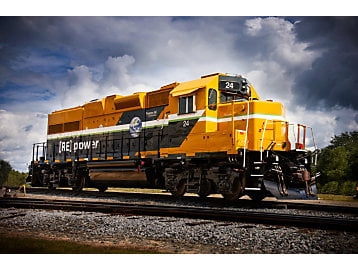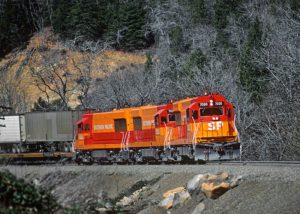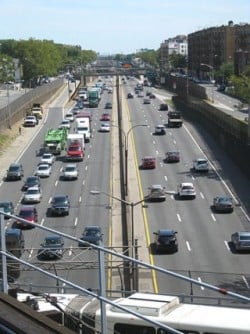Astounding it is how on a gallon of diesel a ton of railroad-hauled freight on average can be transported a distance of approximately 470 miles. Pretty remarkable stuff!
Even more remarkable, substituting diesel with electric propulsion and the fuel-efficiency numbers for train-hauled freight (and passengers) look even better, and even more impressive still, when that electricity is generated cleanly.

Sure, the same could be said of auto travel/motor transport, that is, just how much more fuel-efficient over time light/heavy duty vehicles as well as how much cleaner this side of the transport/travel realm have become.
But, if one were to look at the development histories of railroading and motorized roadway transportation with regard to reduction in exhaust emissions, which one do you think has been more effective at getting that job done? This is the question on the table.
Keeping current, remaining relevant
Railroads, always seeking ways to reinvent themselves – that is to say doing whatever it takes it seems to remain relevant in a highly competitive environment – often go above and beyond and the extra mile as it were to be the best they can be. They are performance- and bottom-line-driven, which is to say that railroads are continuously if not persistently trying to earn higher and higher rates of return on investments, and for good reason which I will explain in more detail in a moment.
We see that as well on the manufacturing and distribution sides of the motor freight equation. And with respect to consumption/purchasing/leasing of light/heavy duty vehicle travel/transport not as much.

To try to remain competitive with trucking, mid-1950s railroading embraced what is today known as TOFC/COFC which is short for trailers/containers on flatcars, this during a time when highway development was still in its infancy. It was as if the railroad industry could see the writing on the wall.
For the rail-common-carrier lines, they recognized early on the advantages in this type of service. One, considerable numbers of trucks with trailers could be removed from often-overcrowded roadways. Two, the trailers and containers could be moved in unit trains made up exclusively of TOFC/COFC freight, which meant that there was no need to yard these type trains at intermediate freight yards en route thus bypassing these facilities which, for the more common manifest or merchandise trains, was more or less standard operating practice. And, three, because of this kind of service being offered, the opportunity presented itself for the forging between railroad and trucking concerns of strategic partnerships, which, as it turned out, has proved to be of benefit in performance terms to each. It’s what you would call a win-win-win in today’s lexicon.
Where rail-based containerized shipping really shined, in a manner of speaking, where the steel wheel meets the steel rail, had to do with the advent of the “double-stack” or more simply “stack” train. In the double-stack arrangement, one container sits atop another – two high compared to an “unstacked” container configuration consisting of a bottom, but minus the container on top. What provided for the double-stacking capability in the flatcar was what is referred to as a deep- or depressed center or well situated between the railcars’ wheel sets. This depressed-well feature also gives the car a lower center of gravity thereby making such more stable.

As a result of the double-stack invention, more containers per train can be handled compared to single-level COFC configurations, which translates into fewer such trains having to be operated. A typical double-stack train can seemingly effortlessly accommodate 240 containers over the length of train required for half that amount (120 containers) outfitted with conventional COFC equipment. All of which as a result led to fewer emissions being produced per train and overall relatively speaking.
Other innovations in freight car and locomotive design have done likewise, one such invention being electro-pneumatic braking as a replacement for standard pneumatic or air braking which, itself, supplanted manual braking which is what was required prior to automatic braking capability being introduced. With manual braking, railroaders physically had to tighten or loosen handbrakes via a hand-wheel which necessitated these “brakemen” to ride atop freight cars. The Positive Train Control system will be yet another of those developments that will lead to even greater efficiencies being realized and, with that, less in the way of negative environmental impact to air.
Unlike in the railroad realm, it is the consumer that dictates what he or she wants in – and expects from – an automobile. And, it is this driving mechanism, if you will, that has brought motorized transport and travel development and technology innovation to where it is today.
‘Horses under the hood’
If you think in terms of horsepower requirements, cars supply more than an ample supply of horses under the hood. In olden days, one horse is all it took to carry on horseback one human being – slim-, medium- and large-framed alike.
With today’s technology, there is enough propulsion capability to carry as many as eight occupants and then some – think minivans.
While not necessarily a bad thing, what is a shortcoming however is that in the U.S. 75 percent of all vehicle commutes are made with driver only. A less efficient utilization of energy consumed per vehicle occupant.

Improvements have come with technologies like hybridization and electrification. Meanwhile, with automotive autonomy looking more and more like this will be the next great breakthrough, should the capability rise to the occasion and be instituted universally, the automotive/truck realm will be transformed even more. By all accounts that day is still a ways away.
The long and short of this whole analysis and discussion is that both modes – trains and motor transport – have on the development front made leaps-and-bounds progress. But, pound for pound, emissions-reduction-wise, train transport is heads-and-shoulders above its counterpart is what I’d say.
Notes
- Oliver Jensen, The American Heritage History of Railroads in America, “[Chapter] 14. The Long Haul,” 1975, p. 274
Images: Copyright © 2020 Environmental Defense Fund. The original material is available at: https://www.edf.org/federal-clean-car-standards (upper); Progress Rail (second); William Grimes (third); Roger Puta (fourth)
This post was last revised on Sept. 21, 2020 @ 8:56 a.m. Pacific Daylight Time.
– Alan Kandel
